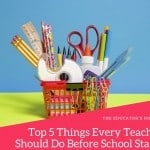Have you signed up for The Educator’s Room Daily Newsletter? Click here and support independent journalism!
I didn’t want to become a runner.
Sure, I participated in track for two years in high school. But saying that I ran track would be more than a little generous. It was more like I showed up for practices, did the best I could, and failed miserably at long jump every Saturday for three months. I also spent nearly every night of each season icing the shin splints that inevitably appeared within the first week of practice.
By the time I was in college I officially decided that running was not my preferred method of exercise.
Then, nearly 20 years after my last track season, we moved to Texas and my husband convinced me to take advantage of the warm winter and start running. I scoffed, but he set out to find me the right pair of running shoes. We went to multiple sporting goods stores, I tried on different brands and styles, and I ran laps around the stores. When I finally found a pair that fit right, I swallowed my pride and admitted that I needed to see running shoes as an investment. I walked out with shoes that made running surprisingly enjoyable and I haven’t looked back. Now, if I don’t run three times a week, I don’t feel right. And while my body may be experiencing the normal aches that come with age, I don’t spend nights on end icing my legs like I did when I was a teenager.
The shoes! The right shoes made all the difference in the world.
In many ways, running shoes are an imperfect metaphor for education in America in 2022. Before the pandemic the system was already fraught with too many problems to count. Two years into pandemic teaching, educators are fighting battles that a global pandemic and polarized political landscape only intensified. Too often, being a teacher feels like trying to run with the wrong pair of shoes. And there are so many choices, so many outside opinions, and so many unknowns once you walk out of the store.
How could education in America be different if it felt like finding the perfect pair of running shoes instead?
Experts need to be in the designing room.
I don’t want someone who isn’t a runner designing and marketing the shoes that I choose to buy, because if they aren’t willing to wear the shoes themselves, why should I? If they aren’t willing to do the work with the tools they have created, why should I? I wouldn’t trust a non-running shoe designer to design my shoes. Yet we let people who haven’t been in a K-12 classroom since they graduated from high school design education policy. If a lawmaker hasn’t spent a significant amount of time in schools of all types and sizes, they don’t have the credibility to tell me how to run my classroom or assess my students. Teachers and administrators at all levels should be a part of every conversation from local school boards to state legislatures.
Even when you stick with the same shoe, you still need an upgrade.
Most running experts say that your shoes should last you 300-500 miles. At first, I didn’t believe that to be true. But I have found that after about six months, I need to start looking for a new pair. My body starts to feel the effects of the pavement a little more and the longer I go without a new pair, the more likely I am to injure myself. But that doesn’t mean that I go out and get an entirely different shoe.
For years before I started running I found myself repeatedly buying the same pair of New Balance shoes every time I looked for new workout shoes. I didn’t do it intentionally. I would try on the shoes and they still fit just right. They were appropriate for aerobic exercise on a padded floor or using the machines at our local YMCA. It wasn’t until I decided to start running that I realized that what had been fine equipment for one activity was now insufficient for another. What had fit and been comfortable now needed to be replaced if I was going to grow in my physical fitness journey.
Teachers don’t always need to completely reform how they teach every time they find their classroom routine getting stale. Sometimes they just need a fresh perspective that comes from a workshop or a book or even a conversation with a colleague. Even the most minor of changes can transform both teaching and learning. Teachers who continue to learn and challenge themselves my discover that they have outgrown one area of their career. When they do, they may discover a need for completely different equipment to follow a new path.
Some shoes fit feet differently than others.
My husband has suggested highly reviewed pairs of running shoes. When I try them on, something just doesn’t feel right. In fact, the only time I really struggled with a pair of shoes was an expensive pair that I bought at REI. The shoes were well rated and people appeared to like them, but after two runs my legs hurt and I was taking too long to recover. They just weren’t the right shoe for me. The same is true for teachers.
Not every situation is great for every teacher. We should encourage and assist every teacher to find the right teaching situation for them. The United States faces significant teacher shortages across the country, but no school should want a teacher in the classroom who does not fit comfortably. That’s not a failure of the teacher or the school. It’s just an indication to make adjustments. If a bad fit is affecting the teaching and the learning in a classroom, then a transition for that teacher will benefit everyone. Just as most people are capable of running with a shoe that provides the right support and balance, with the right support and setting, nearly every teacher can succeed.
The amount of money you spend on a pair of shoes matters.
If you can afford better shoes, you are less likely to be injured. If you are spending less money on shoes, the injuries are greater and you are more likely to quit. As a teenager attempting to run track, my parents couldn’t afford quality running shoes. I spent the two years that I participated in track icing my legs nearly every night because of shin splints. Running never became a part of my regular workouts until years later when I was in my 30s and my husband convinced me to try it again. By that point, I was years behind and I was never going to reach the peak physical condition that I would have maintained if I had never stopped.
Educators who don’t have the resources to effectively teach their students will eventually quit teaching, even if they are potentially excellent teachers. Students who are not given the appropriate resources will also quit learning. This has a ripple effect on their classmates and the community because they are ill-prepared for the workforce and citizenship.
Education is in trouble because we aren’t listening to the experts, supporting teachers, or spending the money where we need to spend it. The refusal to do so is pushing teachers out of the classroom at an unsustainable rate. As a result, we’re leaving children without education experts with the knowledge and skills to teach them at every level.
My personal experience is just one more example of this painful reality.
A year ago I was in a teaching situation that many would consider to be ideal. But I eventually discovered that, like the wrong pair of running shoes, my situation was hurting me. I was hurting in ways I wouldn’t understand until I was forced to find something new. I was so hurt that I swore I would never teach again. How does one heal if they return to the very thing that brought them pain in the first place?
But I decided to try again. I tried on a new job that was the right size, but never quite fit just right. Like my running shoes, I tried to break it in. I tried to ignore the discomfort. While I was happy to be teaching again, it never felt right.
Now I have a new teaching job in a new school in a new state that feels so much better. I’m working at a comfortable pace. While I’m experiencing the normal discomfort that comes with something new, I don’t feel out of place. In this new role, I’m looking forward to getting stronger both inside and outside of the classroom.
Some of us were born to teach, just as some were born to run. And having the support and resources to find the right fit makes all the difference.
Editor’s Note: If you enjoyed this article, please become a Patreon supporter by clicking here.






